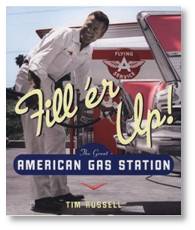In yesterday’s post about efficiency backlash, I said that I never use self-checkout and that is true. But, like pretty much everyone else, I do pump my own gas. But why? Mostly because full-service gas stations tend to be as scarce as hen’s teeth. It didn’t used to be this way. When I was young, full-service gas stations were the norm. You pulled up and an attendant (usually a young man) wearing a uniform hustled out to fill your tank and wash your windshield. If you asked, he would check the oil and tire pressure, too. The driver gave him money—real cash, not plastic—and he took it into the station to make change. He brought the change back out to you and you went on your way without leaving your car, pushing a lot of buttons, or getting the smell of gasoline on your hands.
It didn’t used to be this way. When I was young, full-service gas stations were the norm. You pulled up and an attendant (usually a young man) wearing a uniform hustled out to fill your tank and wash your windshield. If you asked, he would check the oil and tire pressure, too. The driver gave him money—real cash, not plastic—and he took it into the station to make change. He brought the change back out to you and you went on your way without leaving your car, pushing a lot of buttons, or getting the smell of gasoline on your hands.
Short Shorts and Clean Windshields
That service was kind of nice. When my sister and I were teenagers, we would drive our dad’s Chrysler New Yorker (in British Racing Green) to the gas station. If we wore short shorts, the (young male) attendant would wash the windshield three times.
It all changed during the 1973 oil crisis when gas was hard to get and cars lined up outside of filling stations, sometimes for hours. When the crisis was over, self-serve pumps began to appear. It was a clear exchange: you pumped the gas and you paid a lower price per gallon. As the price of gasoline had shot up, from 30 cents a gallon to 40 cents, (about $3.00 in today’s money) lots of us decided this was a good deal and chose the self-serve lane.
I was conflicted about it at the time, though. On the one hand, as local fashion maven Yolanda Celluci once said, “A lady never pumps her own gas.” And I can’t say that I enjoyed the experience of getting out in the cold or the rain to perform a function that a cheerful young man used to do for me. On the other, I figured that a woman can pump her own gas because that made me feel independent and in control.
Providing Free Labor
What I didn’t think back then was that I was providing free labor for the station owners, who no longer had to hire those cheerful young men and could save the money they used to spend on salaries. That became more apparent as the full-serve stations and lanes disappeared and pump-your-own became the only way to keep driving your car.
For years I went to Sudbury Automotive, a discount station that provides both low prices and full service. Now that we’ve moved, I only go there when I’m in the neighborhood. But I have been drawn to the BJ’s that offers gas at about 10 cents a gallon under the going rate and 15 cents per gallon less that the higher-priced stations. I figure that’s worth standing out in the cold.
Most people today accept self-serve as the only way you fill up your car. They have no experience with full service and would probably be shocked if a cheerful young man bounded up to the driver’s window and asked him what grade of gas he wanted. In essence, they don’t know that they are providing free labor and would probably shrug if you told them. After all, this is the way it’s always been for them.
Self Checkout
The problem is that I see this same process at work in other parts of the economy as self-checkout lanes pop up in supermarkets, home goods stores and other retailers—not to mention airport check-in counters. They are sold to us a convenience. Really? For whom? I certainly don’t find it more convenient to find and scan the bar code on my own goods or groceries, bag them myself and pay through a machine. Nor is it usually faster.
I’m not surprised that Sam’s Club, run by the insatiable Walton family, is increasing self-checkout while Costco eliminated it.
Still, people accept these automated check-out lines without wondering why they should perform a function that used to be done for them by an actual employee. They don’t wonder what that former employee is doing now to make a living. They don’t wonder where the greater corporate profits are going, whether it’s into the business or into the CEO’s already overstuffed pocket.
Fat-Cat CEOs
My problem is that I do think about things like this. I can just see those executives pocketing their big salaries and huge bonuses and chuckling at the gullible customers who now work for their company free of charge. And without complaint. It really ticks me off. That’s my efficiency backlash.
It’s also why I don’t use self-serve lines in stores and prefer to give my business to a real employee. I don’t want their jobs to go away and I don’t want to do those jobs for the company. Unless, of course, it’s the only way I can get on the airplane.

